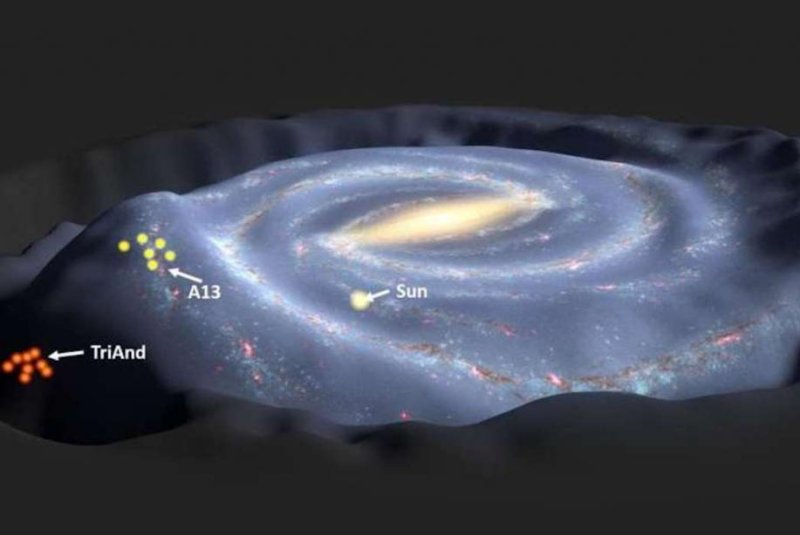Though they exist on either side of the galactic plane -- above and below -- research has shown the Triangulum-Andromeda and the A13 stellar overdensities to be kinetically linked. Photo by T.Mueller/NASA/JPL-Caltech
Feb. 26 (UPI) -- New analysis suggests a group of Milky Way stars among the galaxy's halo actually began life within the central disk.
Like our sun, the majority of the Milky Way's stars are located within the galaxy's central disk. A comparatively smaller portion of stars can be found distributed throughout the galaxy's outer halo.
The star aren't scattered randomly, however. Many of them can be organized into large-scale structures -- structures astronomers believe hold clues to the Milky Way's violent past. Scientists believe at least some of these stellar structures are the remnants of smaller galaxies that have collided with and were absorbed by the Milky Way.
By surveying the chemical composition of the stars found in the Milky Way's halo, astronomers can gain a better understanding of their past.
As part of the latest study, astronomers analyzed the properties of 14 stars located within two stellar structures, Triangulum-Andromeda and the A13 stellar overdensities. Though the two structures are positioned on opposite sides of the galactic plane, previous studies suggest they're kinematically linked and may be related to the Monoceros Ring, a halo structure encircling the entire Milky Way.
Astronomers analyzed the chemical makeup of the two stellar structures using the spectral instruments of the Keck and VLT telescopes.
"The analysis of chemical abundances is a very powerful test, which allows, in a way similar to the DNA matching, to identify the parent population of the star," Maria Bergemann, researcher at the Max Planck Institute for Astronomy in Heidelberg, Germany, said in a news release. "Different parent populations, such as the Milky Way disk or halo, dwarf satellite galaxies or globular clusters, are known to have radically different chemical compositions. So once we know what the stars are made of, we can immediately link them to their parent populations."
The results -- published in the journal Nature -- showed the stars from Tri-And and A13 are related to parent populations from the Milky Way's thin inner disk.
"We showed that it may be fairly common for groups of stars in the disk to be relocated to more distant realms within the Milky Way -- having been 'kicked out' by an invading satellite galaxy. Similar chemical patterns may also be found in other galaxies -- indicating a potential galactic universality of this dynamic process." said study co-author Allyson Shefield, an associate professor of physics at LaGuardia Community College.
While the two halo structures may have origins in the inner galaxy, researchers still think their kinetic connection with one another could be explained by the influence of an invading dwarf galaxy. Astronomers have plans to analyze other stars in Tri-And and A13, as well stars found in more distant halo structures.















